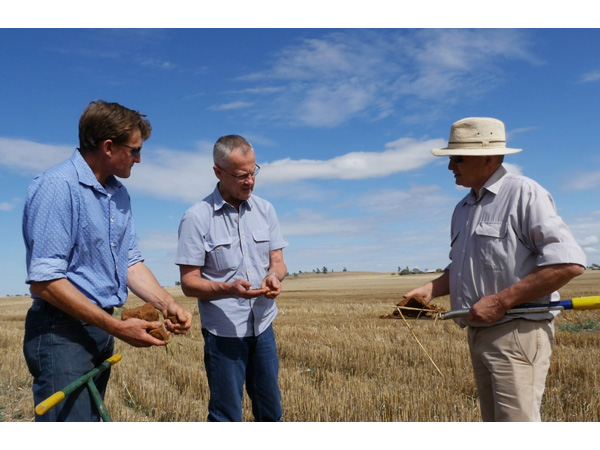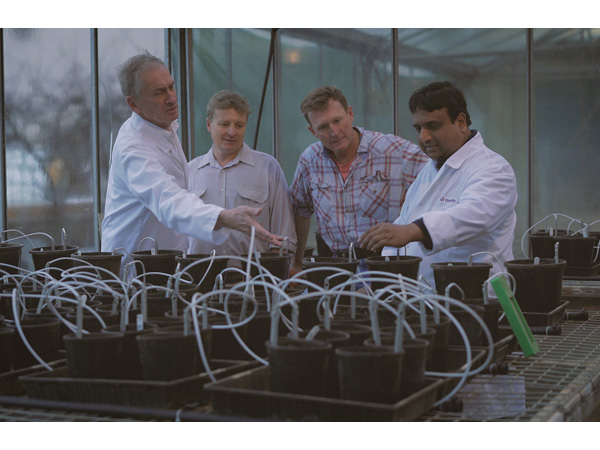Crowdfunding soil health and climate research
By Guy R Webb, Soil C Quest
It took a conversation between an agronomist, a farmer, a Landcare coordinator, and a professor of soil microbiology to spark the creation of ‘Soil C Quest 2031’, a grassroots not-for-profit Australian research institute.
It’s come together by the common ideal that improving soil carbon holds the key to improving agriculture, landscapes, and climate change extremes into the future.

Soil C Quest 2031 directors Mick Wettenhall (left) and Guy Webb (right) discuss the project with Professor Peter McGee (centre) near Forbes NSW.
The organisation is dedicated to the development of practical methods farmers can employ to rapidly store large quantities of carbon in their soils. Based in the New South Wales grain belt at Forbes, Soil C Quest 2031 is currently researching specialised melanised endophytic fungi that facilitate rapid soil carbon sequestration.
The project follows on from initial breakthrough research at the University of Sydney by associate Professor Peter McGee and Dr Tendo Mukasa Mugerwa, who discovered the microbes and their special ability to capture and build soil carbon at unprecedented rates.
The aim of the project is to create a seed inoculum that will ‘fix’ carbon in the soil using these specialist ‘carbon capturing fungi’. The concept is similar in principle to using rhizobium bacteria inoculum on legumes to fix nitrogen in the soil, to which most farmers would be familiar.
Soil organic carbon levels are a true metric of soil health, influencing the infiltration and storage of soil water as well as driving effective nutrient cycling. Soil carbon is simply the foundation of fertility in any soil.

Soil C quest 2031 inspect Eurofins glasshouse research facility in Orange NSW.
Rapidly increasing soil carbon is a sure way to reduce input costs and increase crop yields and farm profitability. This bio-technology may also allow farmers to reliably trade soil carbon credits as carbon trading markets develop, offering a new and potentially lucrative non-extractive farm enterprise.
This biological carbon capture process has been coined ‘fungal mediated soil carbon sequestration’ and is fundamentally a process of capturing and concentrating atmospheric carbon (C02) into plant sugar (C6H1206) and in turn converting some of that carbohydrate flow into fungal melanin (C18H10N204), a stable form of carbon deposited safely inside soil microaggregates.
Worldwide soil carbon levels have declined by over 50 percent. Whilst in the same period atmospheric carbon dioxide levels have increased by 40 percent since the beginning of the industrial revolution. For this reason, this biotechnology represents a very important and timely breakthrough. Transferring the excess carbon dioxide from the air (where it is a major problem) and securely depositing it back into agricultural soils (where it is valued) seems an obvious way to turn a big problem into a big solution.

Team members Mick Wettenhall (farmer) and Guy Webb (agronomist) in a soil pit studying soil aggregation on Micks property near Trangie.
Soil health, food security and climate stability are quite literally everybody’s business, being the foundations of civilisation, of which soil carbon can play a pivotal role. For this reason, Soil C Quest 2031 plan to offer everybody the opportunity of sponsoring a parcel of agricultural land for soil carbon research, through their upcoming crowdfunding campaign this year.
All funds raised will go towards further soil carbon sequestration research so that one day farmers everywhere will be able to economically increase soil carbon stores across large areas of land, offering a real solution for climate change.
For more information, visit www.scq.net.au.



